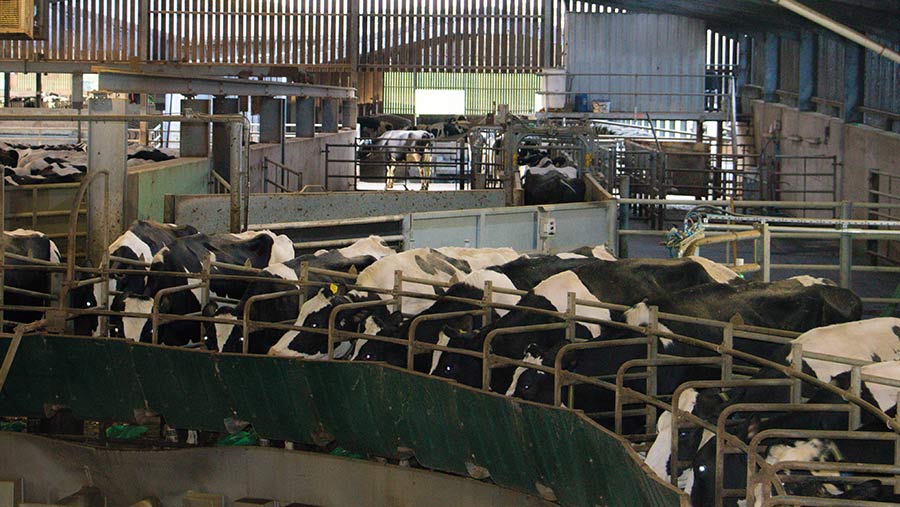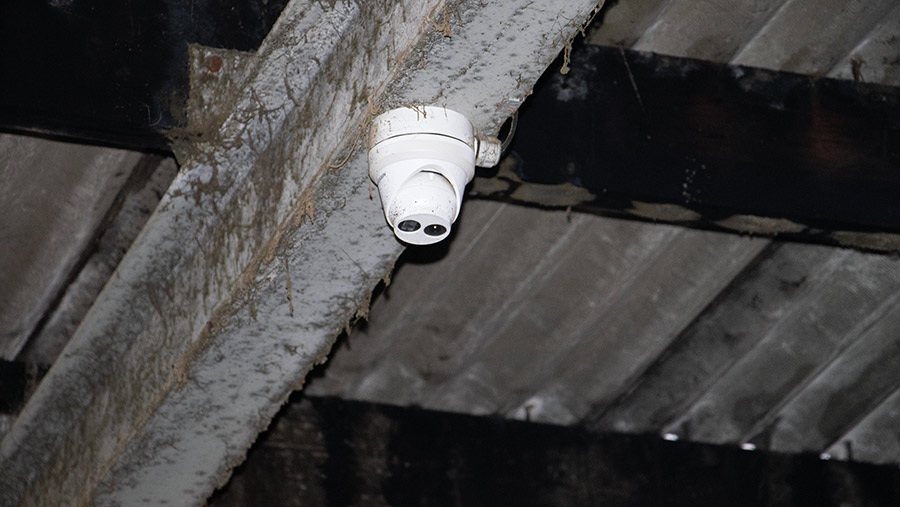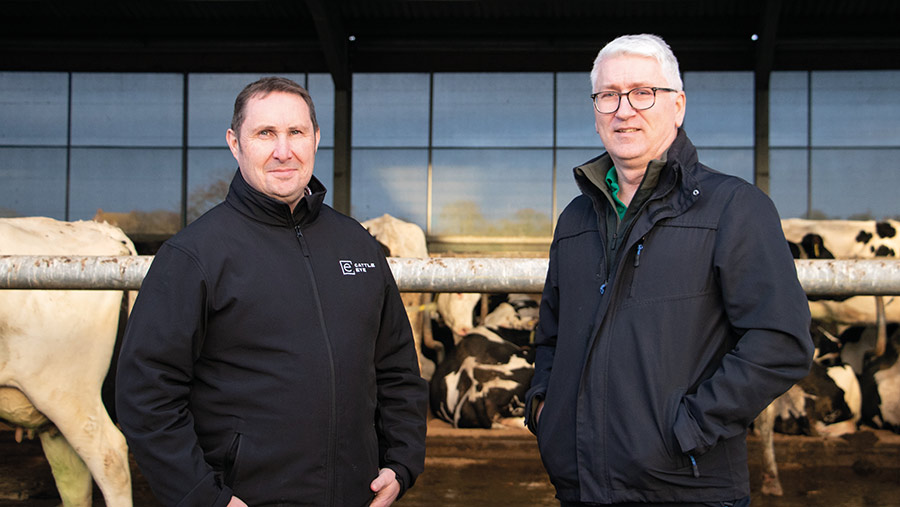How a low-cost camera improves lameness detection for dairy farm
 The camera at Highfields Farm monitors cows in a race as they exit the parlour © Rhian Price/MAG
The camera at Highfields Farm monitors cows in a race as they exit the parlour © Rhian Price/MAG With 1,000 cows going through the parlour three times a day, staff at Highfields Farm in Audlem, Cheshire, wanted something to make detecting lame cows easier.
On the advice of their vet, they decided to install a video camera that automatically monitors the locomotion of individual animals. This is now helping to detect lame cows sooner.
See also: How a strict approach to mobility scoring can cut lameness
How it works
The system uses a low-cost camera mounted over the exit of the parlour which captures footage of each animal as it leaves.
At Highfields Farm, cows exit the rotary parlour and travel down a race to a sorting gate, where the camera is located 4m above the ground.
Each cow is scanned as it walks underneath the camera, and the software runs an artificial intelligence algorithm to pick out key points on each cow and assess its gait.
Farm facts: Highfields Farm, Audlem, Cheshire
- Milking 1,000 cows under the pedigree Rowmar prefix
- All-year-round calving
- Milk sold to Muller/Tesco
- Three-times-a-day milking
- Cows milked through a 50-point rotary parlour
- Averaging 12,400 litres at 3.8% butterfat and 3.3% protein
- Farming 567ha (1,400 acres)
These algorithms have been accredited and validated against two independent Register of Mobility scorers (Roms). Tests carried out by Liverpool University showed the technology was an 89% match with independent human scorers.
Further analysis revealed that the software was actually more accurate at picking up lame cows than the scorers.
The footage captured during milking is recorded initially on a secure digital card and uploaded after milking, with information then displayed via a cloud-based app.
Michael Halliwell, commercial director at CattleEye, explains: “We are not trying to run real-time analysis because the internet quality would inhibit us on many farms.”
Instead, the report is produced the following day, but solutions are being piloted to provide insights within one hour of cows being observed.
Scoring and recording data
Although cows are scored according to the Roms matrix on a scale of 0-3, the app provides a range of 0-100 and maps each score in quartiles. This enables improved detection of possible lame cows, Mr Halliwell says.
“The challenge with scoring cows on a scale of 0-3 is there is still a large variation of lameness within these parameters,” he says.
By using a range of 0-100, thresholds can be tailored to individual farms so that cows are enrolled onto trim lists at different points. This feature is particularly useful for creating different selection criteria based on lactation.

© Rhian Price
“Younger animals typically have better locomotion, so a more moderate deviation in the mobility may warrant a check trim, whereas mobility in older cows tends to be variable, so your threshold may be higher.”
Individual cow scores are displayed on a graph. Observing cows in such a way enables staff to track trends and pick up affected feet before they jump up a score, says John Riley, office manager at Highfields Farm.
The app allows filtering of the data to produce various lists, for example, trim lists for the foot-trimmer or newly lame cows that need attention.
To aid this, the app is synchronised with the herd management programme Uniform-Agri.
This means that when data is uploaded to Uniform-Agri from the foot-trimming programme All4Feet, records are updated seamlessly within CattleEye.
“I tend to look at lame cows and make sure they have been seen [by the foot trimmer],” Mr Riley says. “Currently, the protocol is that any cow that has had a block [applied to the foot] will get seen three weeks later.”
Benefits
Cows at Highfields Farm are routinely foot-trimmed twice during each lactation: 60 days post-calving and between one and six weeks before drying off.
Cows are seen for trimming every Monday and Tuesday – a separate foot-trimming area was set up away from the parlour to allow more time than previously was afforded in between each milking.
Although lameness protocols have not changed since the camera was installed last February, Mr Riley believes they are picking up lame cows much more quickly than before.
“The foot trimmer is doing more cows that haven’t got much wrong with them, which tells me we are picking them up early before they are getting to score 2 or 3,” says Mr Riley.
“It has taken a lot more of the guesswork out of it. It is like having a mobility scorer assess your cows every day.”

Michael Halliwell of CattleEye, left, and Highfields Farm office manager John Riley © Rhian Price
Lameness prevalence has been reduced to a low-teens percentile since the camera was installed.
Since then, there has been a variation in prevalence, but it is still too early to say definitively that lameness levels have been lowered.
This is because cows with persistently poor mobility scores are being worked out of the herd.
Mr Halliwell explains: “Until the farm has been using CattleEye for two years, it is difficult to compare seasonal trends. Some of these trends will allow the farm to identify further opportunities to reduce lameness.
“For example, we know heat stress plays a big factor in lameness, but the effects are usually delayed by two to three months. If we can identify this on a farm, we can decide how to manage that environmental stress.”
He says the important thing is that farmers need an accurate picture of true prevalence to get to the root cause.
“CattleEye scores for sensitivity, so there is going to be a higher range of prevalence, but it removes human error and subjectivity to give us a much more accurate picture of what is happening.”
The future
Mr Riley believes the adoption of new technology is the way forward, especially on larger herds. “I’m almost playing Farming Simulator. I can manage the herd from a laptop – it is incredible,” he says.
“CattleEye isn’t going to make lame cows better, but it will identify them for you sooner.”
Mr Halliwell thinks some herds that use the technology might be able to reduce trimming requirements on score 0 cows.
“One dairy in the US that is milking 1,800 cows has just stopped trimming cows pre-drying off, if they have had no recent hoof issues along with a consistently low mobility score.
“They have been doing it for three months, but it will be another three months – once those cows calve again – before they can tell if the approach is working.”
Would CattleEye work on your farm, and how much does it cost?
CattleEye costs about £1 a cow a month, reducing to 75p a cow a month for larger herds.
The set-up costs are about £500 for the camera and equipment.
It requires electronic identification (EID) and a minimum height of 4m in the parlour exit area, plus 4m of unobstructed walking length for the camera to view.
CattleEye is distributed in the UK by GEA.
